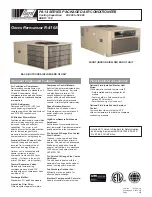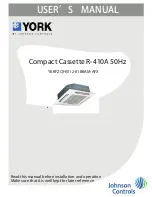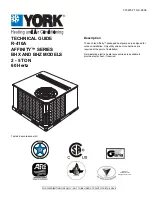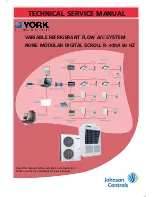
1.5 Instructions for installation and connection of the unit
1.5.1 Characteristics of the location
Location of VIR 25A to 90A indoor units
Locate the indoor unit as close as possible to outdoor walls for easier installation, maintenance and
drainage. Make sure the ceiling fastening where the unit is located will withstand its weight.
The unit must be installed completely horizontally or sloping slightly towards the drain side.
Location of VAC/VAH 20A to 90A outdoor units
The location of the unit must be studied to ensure a completely satisfactory installation. To do so, the
environmental conditions of the area where the unit is to be installed must be taken into account.
Furthermore, the normal weather conditions should be instrumental in determining the best position of
the unit and the hoods, screens or covers required to ensure its correct working order.
If possible, in warm zones like the southern Europe, the unit should be located on the north or east side
of the building or property.
The location chosen for the unit must provide the condenser with an unlimited air supply.
As well as the technical data given in this document and any others that are applicable, please bear in
mind that the unit has been designed for outdoors installation only.
Where the unit is to be installed at ground level, refer to section
Specifications for the foundation or
anchoring of the unit
, see on page 14.
Where the unit is to be installed on the roof of a building or property, make sure that the roof structure
can support the weight of the unit plus that of any optional equipment and/or accessories to be fitted.
Special instructions for locations where there is regular snowfall or with ambient temperatures of close
to 0ºC or less
In areas where there is regular or sporadic snowfall, the unit must be elevated above the ground or roof
where it is installed. The height should be enough to prevent the unit, the condenser and evaporator air
inlets and the access to the unit panels from becoming blocked by accumulated snow.
Protection against ice
In areas where the temperature can drop below 0ºC, there must be some kind of additional protection to
prevent the water in the condensate drain pipe from freezing.
Use a wire heating element in the drain trap as well as in the drain, where applicable.
In heat pumps, also use cord resistors in the outdoor coil tray to prevent any ice from accumulating.
Special instruction for locations with high ambient temperatures
In areas where the ambient temperature is over 43ºC, the unit must not be located in direct sunlight and,
therefore a specific sunshade will be required.
The installation of a special sunshade over the unit must not affect the air flow required by the unit to
work correctly. See
Minimum clearance
, see on page 5.
1.5.2 Characteristics of the facility where the unit will be installed
Indoor unit air ducts
The air duct installation where the unit is to be installed must be formed by a closed return duct system.
The additional installation of economisers or outdoor air intakes is not excluded.
To reduce operating noise, the supply and return air duct connections on the unit must be made using
flexible joints.
The supply and return air duct systems must be designed for the air flow requirements of the installation.
The ducts should not be sized based on the supply and return air connection sizes of the unit.
Quick installation guide
1
Instructions for installation and connection of the unit
1.5
13
Summary of Contents for VAC 20A
Page 3: ...1 Quick installation guide...
Page 26: ...2 Unit installation data...
















































